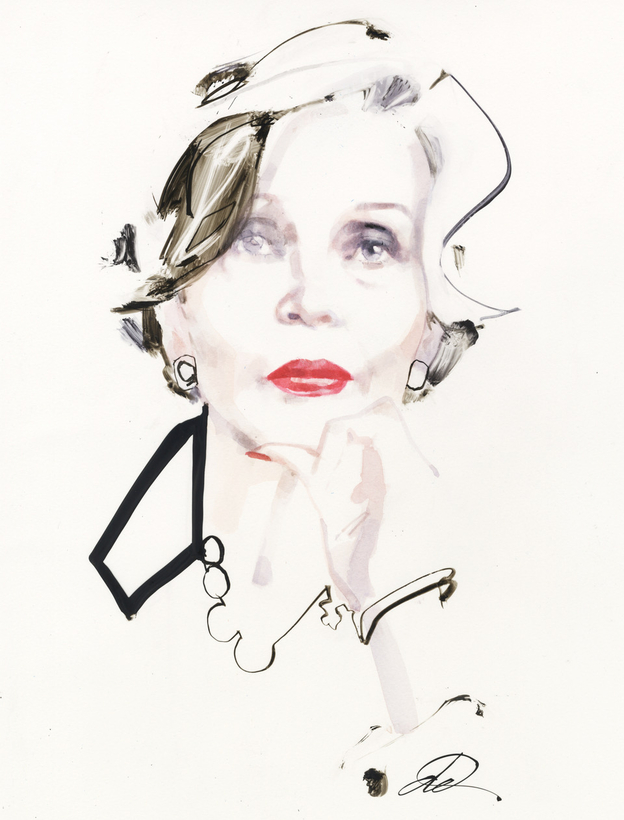I don’t understand how the Parisians let Leslie Caron slip through their hands. In 2013, she sold her apartment overlooking the Musée d’Orsay and moved to London in order to be closer to her children (by the late theater director Sir Peter Hall) and grandchildren. She now lives in some style a short walk, with her dog, Jack (named after the actor Jack Larson), from Kensington Palace.

Paris’s loss is London’s gain. I met Leslie several years ago at a sausage-and-mash supper hosted by Nicky Haslam. I asked her if she would consider sitting for a drawing. She thought about it and called me a few weeks later. The portrait worked out well, and we became fast friends, meeting for regular one o’clock lunches at the Wolseley on Piccadilly. (Although I quickly discovered that, unlike many stars of Hollywood’s golden age, Leslie is early for everything—she puts it down to her MGM training. I learned to arrive promptly at 12:45.)
That MGM training began in 1950. It was a few years after Gene Kelly saw her perform with the Roland Petit ballet company in Paris and brought her to Hollywood as his co-star in An American in Paris (replacing the pregnant Cyd Charisse). “I was a bluestocking, just out of the convent. I had never heard of Gene Kelly and had no interest in films,” she says.

And, to a ration-fed child of the war, California’s land of milk and honey was certainly a revelation. Leslie, 19, spoke almost no English and took all her meals with the crew in their canteen so that she could practice. Ava Gardner ate there, too, for different reasons.
An American in Paris, with its scintillating Gershwin score and swooning re-creations of Impressionist paintings, was an instant classic and led to a string of movies in which Leslie was cast as the world’s orphan: Lili (1953), The Glass Slipper (1955), and Daddy Long Legs (1955), partnering with Fred Astaire. Was she nervous dancing with him? “No! You are nervous working with bad dancers.”

In her best-known role, as Colette’s Gigi in the eponymous 1958 film, she played a 14-year-old being trained as a courtesan, who ultimately blossoms into a sophisticate who chooses love over money. She was 26 at the time, married to Hall, and was accompanied on set by their infant son. In the movie she also got to wear some of the most sublime costumes ever created for the screen, designed by Cecil Beaton. When he showed her the sketch for what would become the celebrated white “Maxim’s dress,” she told him how much she liked the black swallows at the shoulders. “Swallows? They’re ribbons,” said Beaton, “but if you want swallows … ”
Determined to challenge herself, in England Leslie made The Doctor’s Dilemma (1958), based on the George Bernard Shaw play, and The L-Shaped Room (1962), a kitchen-sink drama partially re-written for her, for which she received a second Oscar nomination and won a Golden Globe and a BAFTA. Thereafter, frothy comedies in the 1960s mode with Cary Grant, Rock Hudson, and Warren Beatty, who was named as co-respondent in her divorce from Hall. “Joan [Collins] gave Warren two years, I gave Warren two years, Julie [Christie] gave him four. That was too long,” she says.

An anticipated second career in France didn’t quite materialize. “The French never forgave me for being successful in Hollywood,” she says. And it’s true. Singularly among the great postwar French stars—Signoret, Moreau, Aimée, Deneuve, Adjani—Leslie thrived in America. And most did try. (But not Bardot, who refused to set foot in Hollywood. When she agreed to play a cameo—as herself—in her one bona fide American film, Dear Brigitte, in 1965, the movie’s star, James Stewart, and crew flew to France.)
Still, there were compensations: François Truffaut’s The Man Who Loved Women (1977); Ken Russell’s delirious Valentino (1977), in which she danced with Nureyev; Louis Malle’s Damage (1992); and a pitch-perfect performance as the icy matriarch (based in part on her own mother) in Merchant Ivory’s Le Divorce (2003).
“The French never forgave me for being successful in Hollywood.”
In 2007, she won a Primetime Emmy playing a rape victim on Law & Order: Special Victims Unit, and in 2010 she was a memorable Madame Armfeldt in A Little Night Music, at the Théâtre du Châtelet, in Paris. More recently, from 2016 to 2018, she played on three seasons of the hit TV show The Durrells, produced by her son, Christopher Hall.

And today? “They offer everything to Judi,” she says, referring to Dame Judi Dench, without rancor. At our last lunch, between lockdowns, I told her I’d seen a photo of her as a “rising star of 1952” alongside John Derek, Mitzi Gaynor, Tony Curtis, and Marilyn Monroe. I couldn’t resist asking about Monroe. “She was ravishing, she glowed. And she had no bones. I was all bones! I remember thinking her red velvet dress was so vulgar, scalloped like curtains.” That evening I sent her a copy of the picture. “I’ve got to admit that Marilyn looks spectacular in her dress. A knockout. I was quite wrong about it. She’s wearing the right thing, and I look like Cinderella who belongs in the kitchen,” she laughs.
Thank heaven for Leslie on her 90th birthday. Let’s raise a glass of champagne. It was invented for her.
David Downton is an Editor at Large for Air Mail


